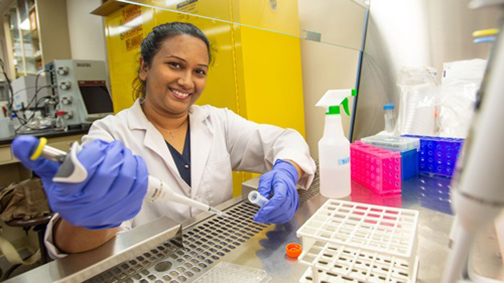by Tim Crosby
CARBONDALE, Ill. – A graduate student researcher at Southern Illinois University Carbondale is developing biological technology aimed at keeping that water bottle you bought last week out of the landfill or worse – the ocean – where it will remain virtually forever.

SIU doctoral student Lakshika Dissanayake tests whether an engineered microbe can upcycle plastic waste. (Photo by Russell Bailey)
Lakshika Dissanayake, who is earning her doctorate in microbiology, is working on an economical and environmentally friendly process that uses microbial factories to turn plastic waste into a value-added material. Much of the work centers on creating a novel bacterium that can break down the commonly used plastic polyethylene terephthalate, or PET, by expressing certain enzymes.
The process, which utilizes a genetically engineered microbe known as Erwinia aphidicola LJJL01, could be the key to creating an efficient, fully biologically based plastics upcycling system, potentially resulting in a circular material economy that greatly reduces pollution.
A worldwide problem
Plastics pollution is quickly becoming one of the main concerns of environmental conservationists, with the world creating almost 140 million metric tons of single-use plastic products in 2021, and experts estimate between 5 and 13 million tons of plastic – much of it PET – end up in the ocean each year.
The concept of recycling everyday materials such as aluminum, paper and plastic has been a centerpiece of conservation efforts for decades. Traditional recycling, however, rarely is economically viable both in terms of processing and market. Worldwide, only about 9% of plastics are recycled each year.
In recent years, the concept of “upcycling” plastic materials has come to the fore. Upcycling involves making higher-grade materials from lower-grade recycled ones, theoretically improving the demand for the products and thereby making it a more economically viable strategy.
Examples include using plastic water bottles to make shoe materials or discarded pallets to make furniture.
But even this method results in waste and landfill use.
Dissanayake said an answer to this developing disaster can’t come too soon.
“Human health, animal life and our environment face severe consequences because of this human-made environmental catastrophe,” she said.
A step beyond
An even newer concept, “biological plastic upcycling,” has become popular in recent years. This revolutionary concept refers to producing high-value products from plastic waste using biological reactions and microbes instead of chemicals.
Scientists have identified a few microbes that degrade PET, as well as the corresponding PET hydrolase enzymes. Previous studies have characterized and engineered these enzymes to selectively depolymerize PET into original monomers, such as terephthalic acid and ethylene glycol, have been successful.
Dissanayake, an Environmental Research & Education Foundation Scholar, hopes to take that work a step further.
“Researchers have developed potential hybrid biological and chemical plastic upcycling strategies,” Dissanayake said. “But a whole microbial system for plastic upcycling is yet to be developed.”
A key to developing such a system is finding the right kind of “bug” to mix in with the waste streams and then improving on it. Erwinia aphidicola LJJL01 seemed promising, because of its presence in waste charcoal used in plastic recycling.
Fashioning the perfect creature
With a promising microbe on deck, Dissanayake and her doctoral adviser, Lahiru Jayakody, assistant professor in the School of Biological Science, set to work studying it.
“First, we conducted a comprehensive characterization of it, to identify its growth conditions and metabolic potential of the strain,” Dissanayake said.
The researchers next used advanced synthetic biological tools, including a method known as plasmid-based transformation. That method involves transferring outside DNA into a host cell, which will then carry both a bacterial origin of replication and an antibiotic resistance gene that researchers can use as a selectable marker in bacteria.
They also used CRISPER-Cas9 technology to engineer the bacterium’s genome for expression and secretions of the enzymes they wanted. CRISPER-Cas9 allows researchers to edit genes by precisely cutting DNA and then letting natural DNA repair processes take over.
The enzymes produced use hydrolysis to break down PET by splitting large molecules into smaller ones.
These souped-up, engineered versions of the bacterium showed great promise in tests at SIU.
“Right now, we are engineering the metabolic pathways of the bacterium to produce high-value chemicals from PET breakdown products,” Dissanayake said. “We have successfully demonstrated we can cause the expression and secretion of these enzymes, and we confirmed that the strains we engineered can completely deconstruct PET, and that they can even outperform commonly used platform strains in other plastic upcycling studies.”
